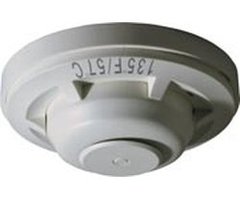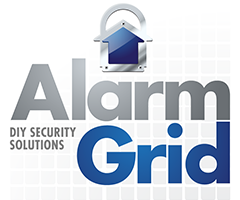System Sensor 5600 Series Heat Detectors - Install Guide Dated 2009
Related Products



Related Categories
Document Transcript
Before Installing
This detector must be installed in compliance with
the control panel installation manual and meet the
requirements of NFPA 72, and/or the local authority
having jurisdiction.
Read this manual carefully before using the detec-
tor. This manual should be left with the owner/user
of this equipment.
General Description
The 5600 series mechanical heat detector is in-
tended for use in property protection applications,
or for non-life-safety installations where smoke de-
tection is not practical or appropriate.
W
ARNING
For life-safety installations, smoke detectors must
be used, in lieu of, or in addition to mechanical heat
detectors.
The 5600 series consists of both single- and dual-
circuit heat detectors featuring fixed temperature
thermal sensors or combination fixed temperature/
rate-of-rise sensors, with temperature ratings of 135ºF
(57ºC) or 194ºF (90ºC).
D500-46-00
1
I56-2175-003R
INSTALLATION AND MAINTENANCE INSTRUCTIONS
3825 Ohio Avenue, St. Charles, Illinois 60174
1-800-SENSOR2, FAX: 630-377-6495
www.systemsensor.com
5600 Series
Mechanical Heat Detector
Single Circuit: 5601P, 5602, 5603, 5604
Dual Circuit: 5621, 5622, 5623, 5624
Markings on the exterior of the detector indicate the
specific activation method and temperature rating. All
models are identified as either 135ºF/57ºC or 194ºF/
90ºC. Models equipped with combination fixed tem
-
perature/rate-of-rise sensors are marked FX/ROR.
Fixed temperature only models are marked FX.
Non-Resettable Fixed Temperature Sensor
The fixed temperature element reacts to heat by re-
sponding to a specific temperature setting (135ºF
or 194ºF). The detection method is based on the
spring action of a metal contact, held to the metal
chamber by a fusible alloy. When the temperature
reaches the alloy’s melting point, the metal contact
will depress the diaphragm, causing the electrical
contact to close the circuit. The circular external
heat collector is released from the detector to visu-
ally indicate that the detector has been activated.
NOTE:
5600 series Fixed Temperature models (5603,
5604, 5623, and 5624) are non-resettable, and can-
not be tested.
Specifications:
Operating Voltage/Contact Ratings (Resistive): 6 – 125 VAC / 3A
6 – 28 VDC / 1A
125 VDC / 0.3A
250 VDC / 0.1A
Maximum Installation Temperature:
Models 5601P, 5603, 5621, and 5623: 100°F (38°C)
Models 5602, 5604, 5622, and 5624: 150°F (65.6°C)
Alarm Temperature:
Models 5601P, 5603, 5621, and 5623: 135°F (57°C)
Models 5602, 5604, 5622, and 5624: 194°F (90°C)
Rate-of-Rise Threshold:
15°F (8.3°C) per minute
(models 5601P, 5602, 5621, and 5622 only)
Operating Humidity Range:
5 to 95% RH non-condensing
Input Terminals:
14 – 22 AWG
Back Box Mounting:
3
1
⁄
2
̋ octagonal
4 ̋ octagonal
Single gang
4 ̋ square with a square to round plaster ring
Dimensions with mounting bracket:
Diameter: 4.57 inches (11.6cm)
Height: 1.69 inches (4.3cm)
Weight:
6 oz. (170 grams)
CAUTION
To prevent the activation of the fixed temperature element, the shipping and storage temperature must not
exceed 122°F (50°C).
I56-2175-003R Self-Restoring Rate-of-Rise (ROR) Sensor
The rate-of-rise element responds to a rapid rise of
temperature, approximately 15ºF (8.3ºC) per min-
ute. As the temperature rises, the air within the
sealed chamber expands. Should the chamber air
expand faster than it can escape through the cali-
brated vent, the diaphragm is depressed, and the
electrical contact closes the circuit.
NOTE:
Only the ROR element of 5600 series com-
bination fixed temperature/ROR models (5601P,
5602, 5621, and 5622) are self-restoring, and may be
tested using a hair dryer or heat gun. When testing
the ROR element, to prevent the activation of the
fixed temperature element, the heat source must not
exceed the fixed temperature rating of the detector.
Mounting Bracket
All 5600 series detectors are equipped with a mount
-
ing bracket that includes mounting slots to accom
-
modate single-gang, 3
1
⁄
2
̋ octagonal, and 4 ̋ octagonal
electrical boxes, as well as 4 ̋ square boxes equipped
with a plaster ring (Figure 1). The mounting bracket
is reversible to accommodate flush-mount and sur
-
face–mount installations (Figure 2).
Wiring Installation Guidelines
All wiring must be installed in compliance with the
National Electrical Code, applicable state and local
codes, and any special requirements of the local
Authority Having Jurisdiction. Proper wire gauges
should be used. The conductors used to connect
heat detectors to the alarm control panel and ac-
cessory devices should be color-coded to reduce the
D500-46-00
2
I56-2175-003R
Heat Detector Type
RTI Classification
Fixed 135°F RTI:
SPECIAL
RoR and Fixed 135°F RTI:
ULTRA FAST and SPECIAL (Respectively)
Fixed 194°F RTI:
SPECIAL
RoR and Fixed 194°F RTI:
ULTRA FAST and SPECIAL (Respectively)
FM Classification
RTI ratings are for installations which must comply with FM 3210.
Table 1. 5600 Series Mechanical Heat Detectors
Model
No.
Circuit
Temperature
Rating
Thermal Sensor
UL Maximum Spacing
(10-foot ceiling)
5601P
Single
135ºF (57ºC)
Fixed Temperature/Rate of Rise
50-feet x 50-feet
5602
Single
194ºF (90ºC)
Fixed Temperature/Rate of Rise
50-feet x 50-feet
5603
Single
135ºF (57ºC)
Fixed Temperature
25-feet x 25-feet
5604
Single
194ºF (90ºC)
Fixed Temperature
25-feet x 25-feet
5621
Dual
135ºF (57ºC)
Fixed Temperature/Rate of Rise
50-feet x 50-feet
5622
Dual
194ºF (90ºC)
Fixed Temperature/Rate of Rise
50-feet x 50-feet
5623
Dual
135ºF (57ºC)
Fixed Temperature
25-feet x 25-feet
5624
Dual
194ºF (90ºC)
Fixed Temperature
25-feet x 25-feet
NOTE:
Refer to NFPA72 guidelines for spacing reductions when ceiling heights exceed 10 feet.
A= 3
1
⁄
2
̋ Octagonal box
B= 4 ̋ Octagonal box
C= Single gang box and 4 ̋
square with plaster ring
D= Directly to W
all/Ceiling
Figure 1. Bracket Mounting Locations:
S0113-00
S0114-00
S0115-00
Surface–mount
Flush–mount
Figure 2. Reversible Mounting Bracket: D500-46-00
3
I56-2175-003R
likelihood of wiring errors. Improper connections
can prevent a system from responding properly in
the event of a fire.
The non-polarized screw terminals on the back of
the detector will accept 14–22 AWG wire. For best
system performance, all wiring should be installed
in separate grounded conduit; do not mix fire alarm
system wiring in the same conduit as any other
electrical wiring. Twisted pair may be used to pro-
vide additional protection against extraneous elec-
trical interference.
Wire connections are made by stripping approxi-
mately
1
⁄
4
̋ of the insulation from the end of the feed
wire, inserting it into the proper base terminal, and
tightening the screw to secure the wire in place.
+
–
EOL
OR
Control
Panel
Auxiliary
Device
Auxiliary
Device
Auxiliary
Device
Auxiliary
Device
Auxiliary
Device
Control
Panel
+
–
OR
EOL
Figure 3. Wiring Diagram – Single Circuit Models:
Figure 4. Wiring Diagram – Dual Circuit Models:
Installation
Remove power from the alarm control unit or initi-
ating device circuits before installing detectors.
1.
Detach the detector from the mounting bracket by
rotating the detector 1⁄4 turn counter-clockwise.
2.
Orient the mounting bracket properly for either a
flush- or surface-mount installation (Figure 2).
3.
Select the pair of mounting holes suitable for the
junction box, (Figure 1) and secure the bracket
to the box.
4.
Connect the wires to the detector per Figure 3 or
Figure 4, as applicable.
5.
Place the detector onto the mounting bracket by
rotating clockwise. The detector will lock into
place with a “click”.
6.
After all detectors have been installed, apply
power to the alarm control unit.
7.
Test each detector as described in Testing.
8.
Reset all the detectors at the alarm control unit.
9.
Notify the proper authorities that the system is
in operation.
S0239-00
S0240-00 D500-46-00
4
I56-2175-003R
©2009 System Sensor
Please refer to insert for the Limitations of Fire Alarm Systems
System Sensor warrants its enclosed product to be
free from defects in materials and workmanship under
normal use and service for a period of three years from
date of manufacture. System Sensor makes no other
express warranty for the enclosed product. No agent,
representative, dealer, or employee of the Company
has the authority to increase or alter the obligations or
limitations of this Warranty. The Company’s obligation
of this Warranty shall be limited to the replacement of
any part of the product which is found to be defec
-
tive in materials or workmanship under normal use
and service during the three year period commencing
with the date of manufacture. After phoning System
Sensor’s toll free number 800-SENSOR2 (736-7672)
for a Return Authorization number, send defective
units postage prepaid to: System Sensor, Returns
FCC Statement
This device complies with part 15 of the FCC Rules. Operation is subject to the following two conditions: (1) This device
may not cause harmful interference, and (2) this device must accept any interference received, including interference that
may cause undesired operation.
NOTE:
This equipment has been tested and found to comply with the limits for a Class B digital device, pursuant to Part
15 of the FCC Rules. These limits are designed to provide reasonable protection against harmful interference in a residential
installation. This equipment generates, uses and can radiate radio frequency energy and, if not installed and used in ac
-
cordance with the instructions, may cause harmful interference to radio communications. However, there is no guarantee
that interference will not occur in a particular installation. If this equipment does cause harmful interference to radio or
television reception, which can be determined by turning the equipment off and on, the user is encouraged to try to correct
the interference by one or more of the following measures:
– Reorient or relocate the receiving antenna.
– Increase the separation between the equipment and receiver.
– Connect the equipment into an outlet on a circuit different from that to which the receiver is connected.
– Consult the dealer or an experienced radio/TV technician for help.
Department, RA #__________, 3825 Ohio Avenue, St.
Charles, IL 60174. Please include a note describing
the malfunction and suspected cause of failure. The
Company shall not be obligated to replace units which
are found to be defective because of damage, unrea
-
sonable use, modifications, or alterations occurring
after the date of manufacture. In no case shall the
Company be liable for any consequential or incidental
damages for breach of this or any other Warranty, ex
-
pressed or implied whatsoever, even if the loss or dam
-
age is caused by the Company’s negligence or fault.
Some states do not allow the exclusion or limitation
of incidental or consequential damages, so the above
limitation or exclusion may not apply to you. This
Warranty gives you specific legal rights, and you may
also have other rights which vary from state to state.
Three-Year Limited Warranty
Testing/Maintenance
The rate-of-rise mechanism may be subject to re-
duced sensitivity over time. Annual testing of the
rate-of-rise operation is therefore recommended.
Before testing, notify the proper authorities that
maintenance is being performed and the system will
be temporarily out of service. Disable the zone or
system undergoing maintenance to prevent any un-
wanted alarms.
Only the ROR element of 5600 series combination
fixed temperature/ROR models (5601P, 5602, 5621,
and 5622) are self-restoring, and may be tested us-
ing a hair dryer or heat gun.
W
ARNING
When testing the ROR element, to prevent the ac-
tivation of the fixed temperature element, the heat
source must not exceed the fixed temperature rating
of the detector.
W
ARNING
5600 series fixed temperature models (5603, 5604,
5623, and 5624) are non-resettable, and cannot
be tested.
CAUTION
When using the RRS-MOD with model 2WTA-B, do
not mix the 2WTA-B with other model smoke de-
tectors and dry contact closure devices, including
mechanical heat detectors, manual pull stations and
waterflow switches. Such mixing can cause a direct
short on the auxiliary power terminals, damaging
the control panel’s internal circuitry and/or damage
devices connected to the initiating device circuit.
- Uploaded



